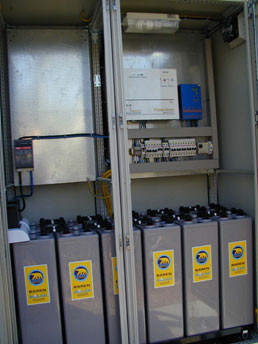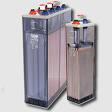Battery maintenance
Battery characteristics
At stations and substations, type C lead-acid batteries are used in open glass containers. The main characteristics of C batteries are nominal capacity, duration and discharge currents, minimum charging current. These values depend on the type, size and number of plates.
Battery capacity during operation
In operation, the capacity of the battery depends on the concentration and temperature of the electrolyte and the discharge mode. As the density of the electrolyte increases, the capacity of the battery increases. Strong solutions, however, contribute to abnormal sulphation of the plates.
Higher temperatures also increase capacity. battery, this can be explained by a decrease in viscosity and increased diffusion of electrolyte in the pores of the plates. But as the temperature rises, the self-discharge of the battery and the sulphation of the plates increase.
It was experimentally established that for stationary batteries of type C, the specific weight of the electrolyte at the beginning of discharge is 1.2 ... 1.21 g / cm3. at a temperature of 25 ° C.The air temperature in the room where the battery is installed must be maintained within 15 ... 20 ° C.
Factors limiting battery discharge
The factors limiting battery discharge are the terminal voltage of the battery and the density of the electrolyte. With a 3 ... 10-hour discharge, a decrease in voltage to 1.8 V is allowed, and with a 1 ... 2-hour discharge, to 1.75 V per cell. Deeper discharges in all modes will damage the batteries. Too long discharges with low currents are stopped when the voltage becomes equal to 1.9 V per cell. During discharge, the voltage of the batteries and the density of the electrolytes in them are monitored. A decrease in density by 0.03 — 0.05 g / cm3 indicates that the capacity is exhausted.
Battery reliability
The reliability of battery operation depends on the condition of the premises where the batteries are placed and on their correct use.
Battery checks
 When checking the batteries, check:
When checking the batteries, check:
1. Vascular integrity and electrolyte level in the batteries, the correct position of the cups, no leaks, cleanliness of the dishes, shelves on walls and floors.
2. The absence of lagging cells in storage battery vessels (usually a vessel with lagging cells has a lower electrolyte density and less gas release compared to neighboring vessels).
3. The reason for the lag is most often short circuits between the plates, which lead to the formation of sediment, loss of active mass and distortion of the plates.
4. The electrolyte level of the rechargeable batteries (the plates in the cells must always be in the electrolyte, the level of which is maintained 10 … 15 mm above the upper edge of the plates).When the electrolyte level drops in the battery, distilled water is added if the electrolyte density is higher than 1.2 g / cm3, or sulfuric acid solution if the electrolyte density is below 1.2 g / cm3.
5. Lack of sulfation (white color), distortion and sticking of adjacent plates — at least once every 2 ... 3 months. The main signs of closing the plates of rechargeable batteries have a reduced voltage and density of the electrolyte in the vessel compared to the neighboring ones.
6. No contact corrosion.
7. Level and nature of sediment in glass vessel batteries (the distance between the bottom edge of the plate and the sediment should be at least 10 mm, and the sediment should be removed to avoid short-circuiting of the plates).
8. Serviceability of Chargers and Chargers.
9. Correctness of ventilation and heating (in winter).
10. Electrolyte temperature (via control elements).

Battery operation
Periodically, at least once a month, check the voltage and electrolyte density of each battery cell. The condition of the insulation is systematically monitored during battery inspections.
The presence of impurities in the electrolyte of the storage battery can lead to the destruction of the plates, and the service life and capacity of the battery are directly dependent on the quality of the electrolyte.
 The most harmful impurities are iron, chlorine, ammonia and manganese. To prevent impurities from entering the electrolyte, distilled water and sulfuric acid are tested in a chemical laboratory. At least once a year, the electrolyte of 1/3 of all elements of a working battery is analyzed.
The most harmful impurities are iron, chlorine, ammonia and manganese. To prevent impurities from entering the electrolyte, distilled water and sulfuric acid are tested in a chemical laboratory. At least once a year, the electrolyte of 1/3 of all elements of a working battery is analyzed.
Battery capacity is checked once every one to two years.
Routine battery repairs are carried out annually and are repaired at least once every 12 to 15 years.
